#Column of Phocas
Photo


View of the Roman Forum with the Column of Phocas and the Temple of Saturn and The Tiber at the Outskirts of Rome by Victor-Jean Nicolle
French, late 18th or early 19th century
pen and brown ink, brush and gray wash over red chalk
Metropolitan Museum of Art x x
#Ancient Rome#Roman Forum#Tiber#Temple of Saturn#Column of Phocas#(which is apparently the last addition made to the Forum in ancient times#dedicated to the Eastern Roman Emperor Phocas in the 7th century)#French#art#drawing#pen and ink#brush and wash#chalk#Victor-Jean Nicolle#ruins#Metropolitan Museum of Art
62 notes
·
View notes
Text
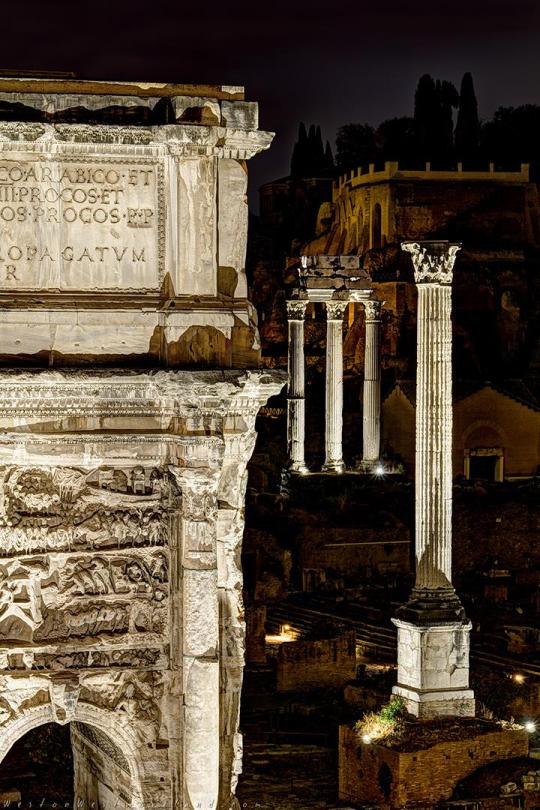
#The Roman Forum and the Palatine Hill. Left to right#the Arch of Septimius Severus#the temple of Castor and Pollux#and the column of Phocas. Behind#in the dark#the Palatine [1080x720]
1 note
·
View note
Text
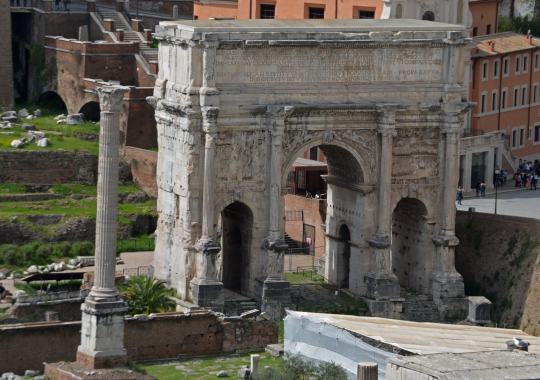
Arch of Septimius Severus (203) and the Column of Phocas (608) in the Forum Romanum
156 notes
·
View notes
Photo
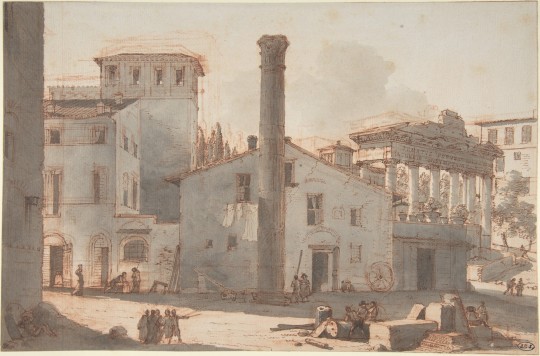
View of the Roman Forum with the Column of Phocas and the Temple of Saturn by Victor-Jean Nicolle
French, late 18th or early 19th century
pen and brown ink, brush and gray wash over red chalk
Metropolitan Museum of Art
0 notes
Photo

The Greek inscription
The dome is 57 feet in diameter, and rests on eight piers, intersected by a double row of thirty-four green and white columns, sixteen of which are in the lower row, and the remaining eighteen in the galleries. The Greek inscription, running round the frieze, is ornamented with carved vine leaves and grapes, and is a dedicatory poem to the two saints; but all the mosaics and frescoes forming part of the original ornamentation of the church have been covered with whitewash. Ducange states that this was the church in which the papal Nuncio, for the time being, was allowed to hold divine service in Latin ; and it was here that Pope Virgil sought refuge from the wrath of Justinian for having excommunicated Patriarch Menas; this was also the church which the Emperor attended in state every Easter Tuesday.
Mehmed Pasha Mosque, on the south-west side of the Hippodrome, not far from Kutchuk Ayiah Sofia. Admission 5 piastres (10d.). This mosque is regarded (Dr. A. G-. Paspati, ‘ BvavnvaX MeXerat ) as the ancient church of St. Anastasia Pharma- kolytria, variously attributed to Anastasius Dicorus, in the fifth century, and to Gregory Nazianzenus, the latter of whom preached orthodoxy in it during the predominance of Arianism in the city. The church has been rebuilt and restored several times, and notably by Basil of Macedon, who replaced its wooden cupola by a stone one.
Most of the ornaments and relics were carried off by the Latins during the crusade of 1204. The immediate vicinity of this church, extending as far as the Cistern of Philoxenus (Thousand and One Columns), is supposed by Dr. Paspati to have been the site of the city Praetorium and the Portico of Domninus. The church was converted into a mosque in 1571 by Mehmed Pasha Socoll, son-in-law of Selim II. The tiles with which the interior is ornamented guided tours istanbul, and especially those forming the panels over the windows and the canopy over the pulpit, are masterpieces of Persian art. The courtyard is one of the most picturesque, and makes a charming subject for sketches or photographs.
The Church in the Fields
The Church in the Fields (17 Movrj TT)? Xwpa?), now Kahriyeh Jamesi, better known to travellers as the Mosaic Mosque. Admission 5 piastres per head. The Imam (priest) in charge is not always in attendance, but lives close by, and will always come if sent for. This mosque suffered so severely during the earthquakes of 1894 as to be in danger of falling down, and it has been deemed advisable, in consequence, to close it for an indefinite period. It is situated near the land walls and close to Edimth Kaj)u (Adrianople Gate); it is one of the most interesting of all the whilom Byzantine churches, both on account of its plan and of the mosaic pictures covering the walls of its outer and inner nartheces, the greater part illustrating the life of Christ. Its Greek name, showing that it originally stood outside the city, carries the foundation back to the period prior to 413 A.D., when it was enclosed within the walls of Theodosius.
Very probably the church was erected as a private chapel in connection with the Hebdomon Palace. Justinian restored it and added a basilica, and in the early part of the seventh century it was further restored and embellished by Crispus, son-in-law of the Emperor Phocas, who was imprisoned in it for treachery by Heraclius, and subsequently became a monk. In the early part of the twelfth century the church was rebuilt and restored by Maria Ducaina, mother-in-law of Alexius Comnenus; and about the middle of the fourteenth century its chapels and nartheces were again restored throughout and embellished by the patrician Theodoras Metochites.
0 notes
Photo

The Greek inscription
The dome is 57 feet in diameter, and rests on eight piers, intersected by a double row of thirty-four green and white columns, sixteen of which are in the lower row, and the remaining eighteen in the galleries. The Greek inscription, running round the frieze, is ornamented with carved vine leaves and grapes, and is a dedicatory poem to the two saints; but all the mosaics and frescoes forming part of the original ornamentation of the church have been covered with whitewash. Ducange states that this was the church in which the papal Nuncio, for the time being, was allowed to hold divine service in Latin ; and it was here that Pope Virgil sought refuge from the wrath of Justinian for having excommunicated Patriarch Menas; this was also the church which the Emperor attended in state every Easter Tuesday.
Mehmed Pasha Mosque, on the south-west side of the Hippodrome, not far from Kutchuk Ayiah Sofia. Admission 5 piastres (10d.). This mosque is regarded (Dr. A. G-. Paspati, ‘ BvavnvaX MeXerat ) as the ancient church of St. Anastasia Pharma- kolytria, variously attributed to Anastasius Dicorus, in the fifth century, and to Gregory Nazianzenus, the latter of whom preached orthodoxy in it during the predominance of Arianism in the city. The church has been rebuilt and restored several times, and notably by Basil of Macedon, who replaced its wooden cupola by a stone one.
Most of the ornaments and relics were carried off by the Latins during the crusade of 1204. The immediate vicinity of this church, extending as far as the Cistern of Philoxenus (Thousand and One Columns), is supposed by Dr. Paspati to have been the site of the city Praetorium and the Portico of Domninus. The church was converted into a mosque in 1571 by Mehmed Pasha Socoll, son-in-law of Selim II. The tiles with which the interior is ornamented guided tours istanbul, and especially those forming the panels over the windows and the canopy over the pulpit, are masterpieces of Persian art. The courtyard is one of the most picturesque, and makes a charming subject for sketches or photographs.
The Church in the Fields
The Church in the Fields (17 Movrj TT)? Xwpa?), now Kahriyeh Jamesi, better known to travellers as the Mosaic Mosque. Admission 5 piastres per head. The Imam (priest) in charge is not always in attendance, but lives close by, and will always come if sent for. This mosque suffered so severely during the earthquakes of 1894 as to be in danger of falling down, and it has been deemed advisable, in consequence, to close it for an indefinite period. It is situated near the land walls and close to Edimth Kaj)u (Adrianople Gate); it is one of the most interesting of all the whilom Byzantine churches, both on account of its plan and of the mosaic pictures covering the walls of its outer and inner nartheces, the greater part illustrating the life of Christ. Its Greek name, showing that it originally stood outside the city, carries the foundation back to the period prior to 413 A.D., when it was enclosed within the walls of Theodosius.
Very probably the church was erected as a private chapel in connection with the Hebdomon Palace. Justinian restored it and added a basilica, and in the early part of the seventh century it was further restored and embellished by Crispus, son-in-law of the Emperor Phocas, who was imprisoned in it for treachery by Heraclius, and subsequently became a monk. In the early part of the twelfth century the church was rebuilt and restored by Maria Ducaina, mother-in-law of Alexius Comnenus; and about the middle of the fourteenth century its chapels and nartheces were again restored throughout and embellished by the patrician Theodoras Metochites.
0 notes
Photo

The Greek inscription
The dome is 57 feet in diameter, and rests on eight piers, intersected by a double row of thirty-four green and white columns, sixteen of which are in the lower row, and the remaining eighteen in the galleries. The Greek inscription, running round the frieze, is ornamented with carved vine leaves and grapes, and is a dedicatory poem to the two saints; but all the mosaics and frescoes forming part of the original ornamentation of the church have been covered with whitewash. Ducange states that this was the church in which the papal Nuncio, for the time being, was allowed to hold divine service in Latin ; and it was here that Pope Virgil sought refuge from the wrath of Justinian for having excommunicated Patriarch Menas; this was also the church which the Emperor attended in state every Easter Tuesday.
Mehmed Pasha Mosque, on the south-west side of the Hippodrome, not far from Kutchuk Ayiah Sofia. Admission 5 piastres (10d.). This mosque is regarded (Dr. A. G-. Paspati, ‘ BvavnvaX MeXerat ) as the ancient church of St. Anastasia Pharma- kolytria, variously attributed to Anastasius Dicorus, in the fifth century, and to Gregory Nazianzenus, the latter of whom preached orthodoxy in it during the predominance of Arianism in the city. The church has been rebuilt and restored several times, and notably by Basil of Macedon, who replaced its wooden cupola by a stone one.
Most of the ornaments and relics were carried off by the Latins during the crusade of 1204. The immediate vicinity of this church, extending as far as the Cistern of Philoxenus (Thousand and One Columns), is supposed by Dr. Paspati to have been the site of the city Praetorium and the Portico of Domninus. The church was converted into a mosque in 1571 by Mehmed Pasha Socoll, son-in-law of Selim II. The tiles with which the interior is ornamented guided tours istanbul, and especially those forming the panels over the windows and the canopy over the pulpit, are masterpieces of Persian art. The courtyard is one of the most picturesque, and makes a charming subject for sketches or photographs.
The Church in the Fields
The Church in the Fields (17 Movrj TT)? Xwpa?), now Kahriyeh Jamesi, better known to travellers as the Mosaic Mosque. Admission 5 piastres per head. The Imam (priest) in charge is not always in attendance, but lives close by, and will always come if sent for. This mosque suffered so severely during the earthquakes of 1894 as to be in danger of falling down, and it has been deemed advisable, in consequence, to close it for an indefinite period. It is situated near the land walls and close to Edimth Kaj)u (Adrianople Gate); it is one of the most interesting of all the whilom Byzantine churches, both on account of its plan and of the mosaic pictures covering the walls of its outer and inner nartheces, the greater part illustrating the life of Christ. Its Greek name, showing that it originally stood outside the city, carries the foundation back to the period prior to 413 A.D., when it was enclosed within the walls of Theodosius.
Very probably the church was erected as a private chapel in connection with the Hebdomon Palace. Justinian restored it and added a basilica, and in the early part of the seventh century it was further restored and embellished by Crispus, son-in-law of the Emperor Phocas, who was imprisoned in it for treachery by Heraclius, and subsequently became a monk. In the early part of the twelfth century the church was rebuilt and restored by Maria Ducaina, mother-in-law of Alexius Comnenus; and about the middle of the fourteenth century its chapels and nartheces were again restored throughout and embellished by the patrician Theodoras Metochites.
0 notes
Photo

The Greek inscription
The dome is 57 feet in diameter, and rests on eight piers, intersected by a double row of thirty-four green and white columns, sixteen of which are in the lower row, and the remaining eighteen in the galleries. The Greek inscription, running round the frieze, is ornamented with carved vine leaves and grapes, and is a dedicatory poem to the two saints; but all the mosaics and frescoes forming part of the original ornamentation of the church have been covered with whitewash. Ducange states that this was the church in which the papal Nuncio, for the time being, was allowed to hold divine service in Latin ; and it was here that Pope Virgil sought refuge from the wrath of Justinian for having excommunicated Patriarch Menas; this was also the church which the Emperor attended in state every Easter Tuesday.
Mehmed Pasha Mosque, on the south-west side of the Hippodrome, not far from Kutchuk Ayiah Sofia. Admission 5 piastres (10d.). This mosque is regarded (Dr. A. G-. Paspati, ‘ BvavnvaX MeXerat ) as the ancient church of St. Anastasia Pharma- kolytria, variously attributed to Anastasius Dicorus, in the fifth century, and to Gregory Nazianzenus, the latter of whom preached orthodoxy in it during the predominance of Arianism in the city. The church has been rebuilt and restored several times, and notably by Basil of Macedon, who replaced its wooden cupola by a stone one.
Most of the ornaments and relics were carried off by the Latins during the crusade of 1204. The immediate vicinity of this church, extending as far as the Cistern of Philoxenus (Thousand and One Columns), is supposed by Dr. Paspati to have been the site of the city Praetorium and the Portico of Domninus. The church was converted into a mosque in 1571 by Mehmed Pasha Socoll, son-in-law of Selim II. The tiles with which the interior is ornamented guided tours istanbul, and especially those forming the panels over the windows and the canopy over the pulpit, are masterpieces of Persian art. The courtyard is one of the most picturesque, and makes a charming subject for sketches or photographs.
The Church in the Fields
The Church in the Fields (17 Movrj TT)? Xwpa?), now Kahriyeh Jamesi, better known to travellers as the Mosaic Mosque. Admission 5 piastres per head. The Imam (priest) in charge is not always in attendance, but lives close by, and will always come if sent for. This mosque suffered so severely during the earthquakes of 1894 as to be in danger of falling down, and it has been deemed advisable, in consequence, to close it for an indefinite period. It is situated near the land walls and close to Edimth Kaj)u (Adrianople Gate); it is one of the most interesting of all the whilom Byzantine churches, both on account of its plan and of the mosaic pictures covering the walls of its outer and inner nartheces, the greater part illustrating the life of Christ. Its Greek name, showing that it originally stood outside the city, carries the foundation back to the period prior to 413 A.D., when it was enclosed within the walls of Theodosius.
Very probably the church was erected as a private chapel in connection with the Hebdomon Palace. Justinian restored it and added a basilica, and in the early part of the seventh century it was further restored and embellished by Crispus, son-in-law of the Emperor Phocas, who was imprisoned in it for treachery by Heraclius, and subsequently became a monk. In the early part of the twelfth century the church was rebuilt and restored by Maria Ducaina, mother-in-law of Alexius Comnenus; and about the middle of the fourteenth century its chapels and nartheces were again restored throughout and embellished by the patrician Theodoras Metochites.
0 notes
Photo
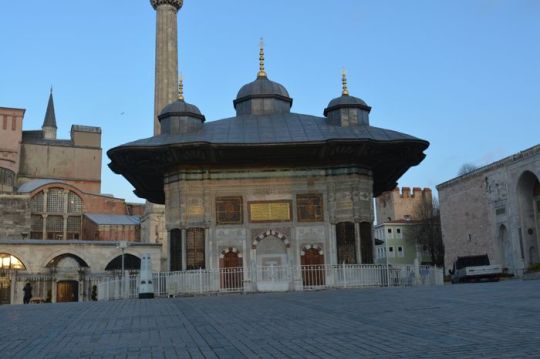
The Greek inscription
The dome is 57 feet in diameter, and rests on eight piers, intersected by a double row of thirty-four green and white columns, sixteen of which are in the lower row, and the remaining eighteen in the galleries. The Greek inscription, running round the frieze, is ornamented with carved vine leaves and grapes, and is a dedicatory poem to the two saints; but all the mosaics and frescoes forming part of the original ornamentation of the church have been covered with whitewash. Ducange states that this was the church in which the papal Nuncio, for the time being, was allowed to hold divine service in Latin ; and it was here that Pope Virgil sought refuge from the wrath of Justinian for having excommunicated Patriarch Menas; this was also the church which the Emperor attended in state every Easter Tuesday.
Mehmed Pasha Mosque, on the south-west side of the Hippodrome, not far from Kutchuk Ayiah Sofia. Admission 5 piastres (10d.). This mosque is regarded (Dr. A. G-. Paspati, ‘ BvavnvaX MeXerat ) as the ancient church of St. Anastasia Pharma- kolytria, variously attributed to Anastasius Dicorus, in the fifth century, and to Gregory Nazianzenus, the latter of whom preached orthodoxy in it during the predominance of Arianism in the city. The church has been rebuilt and restored several times, and notably by Basil of Macedon, who replaced its wooden cupola by a stone one.
Most of the ornaments and relics were carried off by the Latins during the crusade of 1204. The immediate vicinity of this church, extending as far as the Cistern of Philoxenus (Thousand and One Columns), is supposed by Dr. Paspati to have been the site of the city Praetorium and the Portico of Domninus. The church was converted into a mosque in 1571 by Mehmed Pasha Socoll, son-in-law of Selim II. The tiles with which the interior is ornamented guided tours istanbul, and especially those forming the panels over the windows and the canopy over the pulpit, are masterpieces of Persian art. The courtyard is one of the most picturesque, and makes a charming subject for sketches or photographs.
The Church in the Fields
The Church in the Fields (17 Movrj TT)? Xwpa?), now Kahriyeh Jamesi, better known to travellers as the Mosaic Mosque. Admission 5 piastres per head. The Imam (priest) in charge is not always in attendance, but lives close by, and will always come if sent for. This mosque suffered so severely during the earthquakes of 1894 as to be in danger of falling down, and it has been deemed advisable, in consequence, to close it for an indefinite period. It is situated near the land walls and close to Edimth Kaj)u (Adrianople Gate); it is one of the most interesting of all the whilom Byzantine churches, both on account of its plan and of the mosaic pictures covering the walls of its outer and inner nartheces, the greater part illustrating the life of Christ. Its Greek name, showing that it originally stood outside the city, carries the foundation back to the period prior to 413 A.D., when it was enclosed within the walls of Theodosius.
Very probably the church was erected as a private chapel in connection with the Hebdomon Palace. Justinian restored it and added a basilica, and in the early part of the seventh century it was further restored and embellished by Crispus, son-in-law of the Emperor Phocas, who was imprisoned in it for treachery by Heraclius, and subsequently became a monk. In the early part of the twelfth century the church was rebuilt and restored by Maria Ducaina, mother-in-law of Alexius Comnenus; and about the middle of the fourteenth century its chapels and nartheces were again restored throughout and embellished by the patrician Theodoras Metochites.
0 notes
Photo
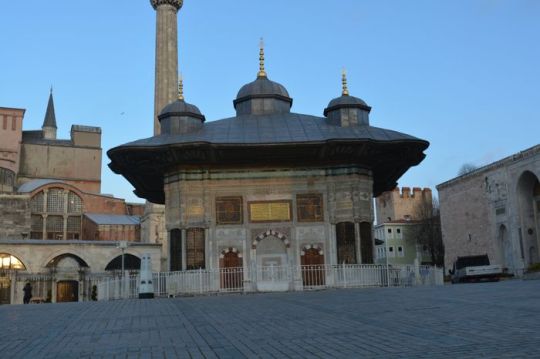
The Greek inscription
The dome is 57 feet in diameter, and rests on eight piers, intersected by a double row of thirty-four green and white columns, sixteen of which are in the lower row, and the remaining eighteen in the galleries. The Greek inscription, running round the frieze, is ornamented with carved vine leaves and grapes, and is a dedicatory poem to the two saints; but all the mosaics and frescoes forming part of the original ornamentation of the church have been covered with whitewash. Ducange states that this was the church in which the papal Nuncio, for the time being, was allowed to hold divine service in Latin ; and it was here that Pope Virgil sought refuge from the wrath of Justinian for having excommunicated Patriarch Menas; this was also the church which the Emperor attended in state every Easter Tuesday.
Mehmed Pasha Mosque, on the south-west side of the Hippodrome, not far from Kutchuk Ayiah Sofia. Admission 5 piastres (10d.). This mosque is regarded (Dr. A. G-. Paspati, ‘ BvavnvaX MeXerat ) as the ancient church of St. Anastasia Pharma- kolytria, variously attributed to Anastasius Dicorus, in the fifth century, and to Gregory Nazianzenus, the latter of whom preached orthodoxy in it during the predominance of Arianism in the city. The church has been rebuilt and restored several times, and notably by Basil of Macedon, who replaced its wooden cupola by a stone one.
Most of the ornaments and relics were carried off by the Latins during the crusade of 1204. The immediate vicinity of this church, extending as far as the Cistern of Philoxenus (Thousand and One Columns), is supposed by Dr. Paspati to have been the site of the city Praetorium and the Portico of Domninus. The church was converted into a mosque in 1571 by Mehmed Pasha Socoll, son-in-law of Selim II. The tiles with which the interior is ornamented guided tours istanbul, and especially those forming the panels over the windows and the canopy over the pulpit, are masterpieces of Persian art. The courtyard is one of the most picturesque, and makes a charming subject for sketches or photographs.
The Church in the Fields
The Church in the Fields (17 Movrj TT)? Xwpa?), now Kahriyeh Jamesi, better known to travellers as the Mosaic Mosque. Admission 5 piastres per head. The Imam (priest) in charge is not always in attendance, but lives close by, and will always come if sent for. This mosque suffered so severely during the earthquakes of 1894 as to be in danger of falling down, and it has been deemed advisable, in consequence, to close it for an indefinite period. It is situated near the land walls and close to Edimth Kaj)u (Adrianople Gate); it is one of the most interesting of all the whilom Byzantine churches, both on account of its plan and of the mosaic pictures covering the walls of its outer and inner nartheces, the greater part illustrating the life of Christ. Its Greek name, showing that it originally stood outside the city, carries the foundation back to the period prior to 413 A.D., when it was enclosed within the walls of Theodosius.
Very probably the church was erected as a private chapel in connection with the Hebdomon Palace. Justinian restored it and added a basilica, and in the early part of the seventh century it was further restored and embellished by Crispus, son-in-law of the Emperor Phocas, who was imprisoned in it for treachery by Heraclius, and subsequently became a monk. In the early part of the twelfth century the church was rebuilt and restored by Maria Ducaina, mother-in-law of Alexius Comnenus; and about the middle of the fourteenth century its chapels and nartheces were again restored throughout and embellished by the patrician Theodoras Metochites.
0 notes
Photo
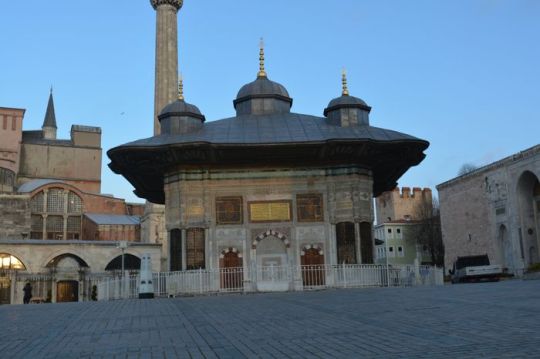
The Greek inscription
The dome is 57 feet in diameter, and rests on eight piers, intersected by a double row of thirty-four green and white columns, sixteen of which are in the lower row, and the remaining eighteen in the galleries. The Greek inscription, running round the frieze, is ornamented with carved vine leaves and grapes, and is a dedicatory poem to the two saints; but all the mosaics and frescoes forming part of the original ornamentation of the church have been covered with whitewash. Ducange states that this was the church in which the papal Nuncio, for the time being, was allowed to hold divine service in Latin ; and it was here that Pope Virgil sought refuge from the wrath of Justinian for having excommunicated Patriarch Menas; this was also the church which the Emperor attended in state every Easter Tuesday.
Mehmed Pasha Mosque, on the south-west side of the Hippodrome, not far from Kutchuk Ayiah Sofia. Admission 5 piastres (10d.). This mosque is regarded (Dr. A. G-. Paspati, ‘ BvavnvaX MeXerat ) as the ancient church of St. Anastasia Pharma- kolytria, variously attributed to Anastasius Dicorus, in the fifth century, and to Gregory Nazianzenus, the latter of whom preached orthodoxy in it during the predominance of Arianism in the city. The church has been rebuilt and restored several times, and notably by Basil of Macedon, who replaced its wooden cupola by a stone one.
Most of the ornaments and relics were carried off by the Latins during the crusade of 1204. The immediate vicinity of this church, extending as far as the Cistern of Philoxenus (Thousand and One Columns), is supposed by Dr. Paspati to have been the site of the city Praetorium and the Portico of Domninus. The church was converted into a mosque in 1571 by Mehmed Pasha Socoll, son-in-law of Selim II. The tiles with which the interior is ornamented guided tours istanbul, and especially those forming the panels over the windows and the canopy over the pulpit, are masterpieces of Persian art. The courtyard is one of the most picturesque, and makes a charming subject for sketches or photographs.
The Church in the Fields
The Church in the Fields (17 Movrj TT)? Xwpa?), now Kahriyeh Jamesi, better known to travellers as the Mosaic Mosque. Admission 5 piastres per head. The Imam (priest) in charge is not always in attendance, but lives close by, and will always come if sent for. This mosque suffered so severely during the earthquakes of 1894 as to be in danger of falling down, and it has been deemed advisable, in consequence, to close it for an indefinite period. It is situated near the land walls and close to Edimth Kaj)u (Adrianople Gate); it is one of the most interesting of all the whilom Byzantine churches, both on account of its plan and of the mosaic pictures covering the walls of its outer and inner nartheces, the greater part illustrating the life of Christ. Its Greek name, showing that it originally stood outside the city, carries the foundation back to the period prior to 413 A.D., when it was enclosed within the walls of Theodosius.
Very probably the church was erected as a private chapel in connection with the Hebdomon Palace. Justinian restored it and added a basilica, and in the early part of the seventh century it was further restored and embellished by Crispus, son-in-law of the Emperor Phocas, who was imprisoned in it for treachery by Heraclius, and subsequently became a monk. In the early part of the twelfth century the church was rebuilt and restored by Maria Ducaina, mother-in-law of Alexius Comnenus; and about the middle of the fourteenth century its chapels and nartheces were again restored throughout and embellished by the patrician Theodoras Metochites.
0 notes
Photo
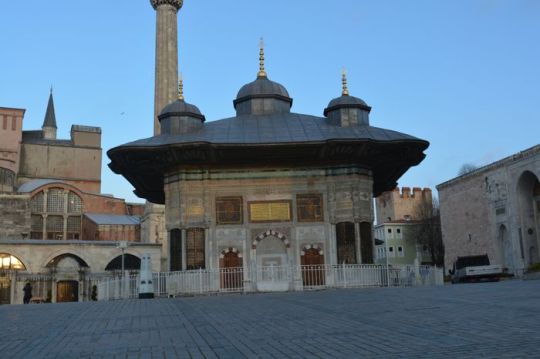
The Greek inscription
The dome is 57 feet in diameter, and rests on eight piers, intersected by a double row of thirty-four green and white columns, sixteen of which are in the lower row, and the remaining eighteen in the galleries. The Greek inscription, running round the frieze, is ornamented with carved vine leaves and grapes, and is a dedicatory poem to the two saints; but all the mosaics and frescoes forming part of the original ornamentation of the church have been covered with whitewash. Ducange states that this was the church in which the papal Nuncio, for the time being, was allowed to hold divine service in Latin ; and it was here that Pope Virgil sought refuge from the wrath of Justinian for having excommunicated Patriarch Menas; this was also the church which the Emperor attended in state every Easter Tuesday.
Mehmed Pasha Mosque, on the south-west side of the Hippodrome, not far from Kutchuk Ayiah Sofia. Admission 5 piastres (10d.). This mosque is regarded (Dr. A. G-. Paspati, ‘ BvavnvaX MeXerat ) as the ancient church of St. Anastasia Pharma- kolytria, variously attributed to Anastasius Dicorus, in the fifth century, and to Gregory Nazianzenus, the latter of whom preached orthodoxy in it during the predominance of Arianism in the city. The church has been rebuilt and restored several times, and notably by Basil of Macedon, who replaced its wooden cupola by a stone one.
Most of the ornaments and relics were carried off by the Latins during the crusade of 1204. The immediate vicinity of this church, extending as far as the Cistern of Philoxenus (Thousand and One Columns), is supposed by Dr. Paspati to have been the site of the city Praetorium and the Portico of Domninus. The church was converted into a mosque in 1571 by Mehmed Pasha Socoll, son-in-law of Selim II. The tiles with which the interior is ornamented guided tours istanbul, and especially those forming the panels over the windows and the canopy over the pulpit, are masterpieces of Persian art. The courtyard is one of the most picturesque, and makes a charming subject for sketches or photographs.
The Church in the Fields
The Church in the Fields (17 Movrj TT)? Xwpa?), now Kahriyeh Jamesi, better known to travellers as the Mosaic Mosque. Admission 5 piastres per head. The Imam (priest) in charge is not always in attendance, but lives close by, and will always come if sent for. This mosque suffered so severely during the earthquakes of 1894 as to be in danger of falling down, and it has been deemed advisable, in consequence, to close it for an indefinite period. It is situated near the land walls and close to Edimth Kaj)u (Adrianople Gate); it is one of the most interesting of all the whilom Byzantine churches, both on account of its plan and of the mosaic pictures covering the walls of its outer and inner nartheces, the greater part illustrating the life of Christ. Its Greek name, showing that it originally stood outside the city, carries the foundation back to the period prior to 413 A.D., when it was enclosed within the walls of Theodosius.
Very probably the church was erected as a private chapel in connection with the Hebdomon Palace. Justinian restored it and added a basilica, and in the early part of the seventh century it was further restored and embellished by Crispus, son-in-law of the Emperor Phocas, who was imprisoned in it for treachery by Heraclius, and subsequently became a monk. In the early part of the twelfth century the church was rebuilt and restored by Maria Ducaina, mother-in-law of Alexius Comnenus; and about the middle of the fourteenth century its chapels and nartheces were again restored throughout and embellished by the patrician Theodoras Metochites.
0 notes
Photo
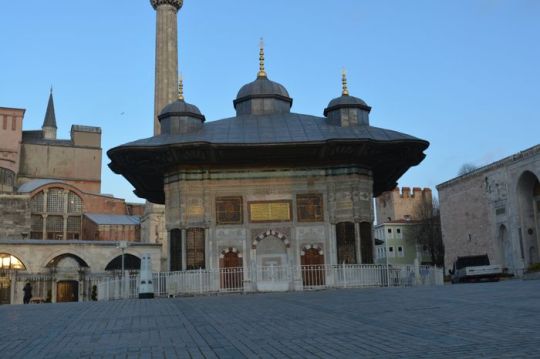
The Greek inscription
The dome is 57 feet in diameter, and rests on eight piers, intersected by a double row of thirty-four green and white columns, sixteen of which are in the lower row, and the remaining eighteen in the galleries. The Greek inscription, running round the frieze, is ornamented with carved vine leaves and grapes, and is a dedicatory poem to the two saints; but all the mosaics and frescoes forming part of the original ornamentation of the church have been covered with whitewash. Ducange states that this was the church in which the papal Nuncio, for the time being, was allowed to hold divine service in Latin ; and it was here that Pope Virgil sought refuge from the wrath of Justinian for having excommunicated Patriarch Menas; this was also the church which the Emperor attended in state every Easter Tuesday.
Mehmed Pasha Mosque, on the south-west side of the Hippodrome, not far from Kutchuk Ayiah Sofia. Admission 5 piastres (10d.). This mosque is regarded (Dr. A. G-. Paspati, ‘ BvavnvaX MeXerat ) as the ancient church of St. Anastasia Pharma- kolytria, variously attributed to Anastasius Dicorus, in the fifth century, and to Gregory Nazianzenus, the latter of whom preached orthodoxy in it during the predominance of Arianism in the city. The church has been rebuilt and restored several times, and notably by Basil of Macedon, who replaced its wooden cupola by a stone one.
Most of the ornaments and relics were carried off by the Latins during the crusade of 1204. The immediate vicinity of this church, extending as far as the Cistern of Philoxenus (Thousand and One Columns), is supposed by Dr. Paspati to have been the site of the city Praetorium and the Portico of Domninus. The church was converted into a mosque in 1571 by Mehmed Pasha Socoll, son-in-law of Selim II. The tiles with which the interior is ornamented guided tours istanbul, and especially those forming the panels over the windows and the canopy over the pulpit, are masterpieces of Persian art. The courtyard is one of the most picturesque, and makes a charming subject for sketches or photographs.
The Church in the Fields
The Church in the Fields (17 Movrj TT)? Xwpa?), now Kahriyeh Jamesi, better known to travellers as the Mosaic Mosque. Admission 5 piastres per head. The Imam (priest) in charge is not always in attendance, but lives close by, and will always come if sent for. This mosque suffered so severely during the earthquakes of 1894 as to be in danger of falling down, and it has been deemed advisable, in consequence, to close it for an indefinite period. It is situated near the land walls and close to Edimth Kaj)u (Adrianople Gate); it is one of the most interesting of all the whilom Byzantine churches, both on account of its plan and of the mosaic pictures covering the walls of its outer and inner nartheces, the greater part illustrating the life of Christ. Its Greek name, showing that it originally stood outside the city, carries the foundation back to the period prior to 413 A.D., when it was enclosed within the walls of Theodosius.
Very probably the church was erected as a private chapel in connection with the Hebdomon Palace. Justinian restored it and added a basilica, and in the early part of the seventh century it was further restored and embellished by Crispus, son-in-law of the Emperor Phocas, who was imprisoned in it for treachery by Heraclius, and subsequently became a monk. In the early part of the twelfth century the church was rebuilt and restored by Maria Ducaina, mother-in-law of Alexius Comnenus; and about the middle of the fourteenth century its chapels and nartheces were again restored throughout and embellished by the patrician Theodoras Metochites.
0 notes
Photo
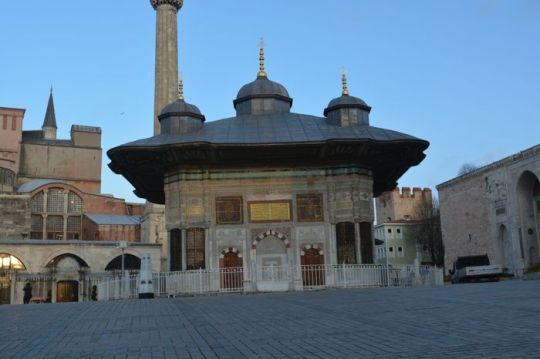
The Greek inscription
The dome is 57 feet in diameter, and rests on eight piers, intersected by a double row of thirty-four green and white columns, sixteen of which are in the lower row, and the remaining eighteen in the galleries. The Greek inscription, running round the frieze, is ornamented with carved vine leaves and grapes, and is a dedicatory poem to the two saints; but all the mosaics and frescoes forming part of the original ornamentation of the church have been covered with whitewash. Ducange states that this was the church in which the papal Nuncio, for the time being, was allowed to hold divine service in Latin ; and it was here that Pope Virgil sought refuge from the wrath of Justinian for having excommunicated Patriarch Menas; this was also the church which the Emperor attended in state every Easter Tuesday.
Mehmed Pasha Mosque, on the south-west side of the Hippodrome, not far from Kutchuk Ayiah Sofia. Admission 5 piastres (10d.). This mosque is regarded (Dr. A. G-. Paspati, ‘ BvavnvaX MeXerat ) as the ancient church of St. Anastasia Pharma- kolytria, variously attributed to Anastasius Dicorus, in the fifth century, and to Gregory Nazianzenus, the latter of whom preached orthodoxy in it during the predominance of Arianism in the city. The church has been rebuilt and restored several times, and notably by Basil of Macedon, who replaced its wooden cupola by a stone one.
Most of the ornaments and relics were carried off by the Latins during the crusade of 1204. The immediate vicinity of this church, extending as far as the Cistern of Philoxenus (Thousand and One Columns), is supposed by Dr. Paspati to have been the site of the city Praetorium and the Portico of Domninus. The church was converted into a mosque in 1571 by Mehmed Pasha Socoll, son-in-law of Selim II. The tiles with which the interior is ornamented guided tours istanbul, and especially those forming the panels over the windows and the canopy over the pulpit, are masterpieces of Persian art. The courtyard is one of the most picturesque, and makes a charming subject for sketches or photographs.
The Church in the Fields
The Church in the Fields (17 Movrj TT)? Xwpa?), now Kahriyeh Jamesi, better known to travellers as the Mosaic Mosque. Admission 5 piastres per head. The Imam (priest) in charge is not always in attendance, but lives close by, and will always come if sent for. This mosque suffered so severely during the earthquakes of 1894 as to be in danger of falling down, and it has been deemed advisable, in consequence, to close it for an indefinite period. It is situated near the land walls and close to Edimth Kaj)u (Adrianople Gate); it is one of the most interesting of all the whilom Byzantine churches, both on account of its plan and of the mosaic pictures covering the walls of its outer and inner nartheces, the greater part illustrating the life of Christ. Its Greek name, showing that it originally stood outside the city, carries the foundation back to the period prior to 413 A.D., when it was enclosed within the walls of Theodosius.
Very probably the church was erected as a private chapel in connection with the Hebdomon Palace. Justinian restored it and added a basilica, and in the early part of the seventh century it was further restored and embellished by Crispus, son-in-law of the Emperor Phocas, who was imprisoned in it for treachery by Heraclius, and subsequently became a monk. In the early part of the twelfth century the church was rebuilt and restored by Maria Ducaina, mother-in-law of Alexius Comnenus; and about the middle of the fourteenth century its chapels and nartheces were again restored throughout and embellished by the patrician Theodoras Metochites.
0 notes
Photo
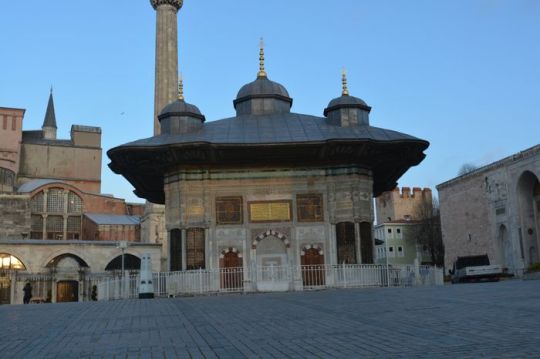
The Greek inscription
The dome is 57 feet in diameter, and rests on eight piers, intersected by a double row of thirty-four green and white columns, sixteen of which are in the lower row, and the remaining eighteen in the galleries. The Greek inscription, running round the frieze, is ornamented with carved vine leaves and grapes, and is a dedicatory poem to the two saints; but all the mosaics and frescoes forming part of the original ornamentation of the church have been covered with whitewash. Ducange states that this was the church in which the papal Nuncio, for the time being, was allowed to hold divine service in Latin ; and it was here that Pope Virgil sought refuge from the wrath of Justinian for having excommunicated Patriarch Menas; this was also the church which the Emperor attended in state every Easter Tuesday.
Mehmed Pasha Mosque, on the south-west side of the Hippodrome, not far from Kutchuk Ayiah Sofia. Admission 5 piastres (10d.). This mosque is regarded (Dr. A. G-. Paspati, ‘ BvavnvaX MeXerat ) as the ancient church of St. Anastasia Pharma- kolytria, variously attributed to Anastasius Dicorus, in the fifth century, and to Gregory Nazianzenus, the latter of whom preached orthodoxy in it during the predominance of Arianism in the city. The church has been rebuilt and restored several times, and notably by Basil of Macedon, who replaced its wooden cupola by a stone one.
Most of the ornaments and relics were carried off by the Latins during the crusade of 1204. The immediate vicinity of this church, extending as far as the Cistern of Philoxenus (Thousand and One Columns), is supposed by Dr. Paspati to have been the site of the city Praetorium and the Portico of Domninus. The church was converted into a mosque in 1571 by Mehmed Pasha Socoll, son-in-law of Selim II. The tiles with which the interior is ornamented guided tours istanbul, and especially those forming the panels over the windows and the canopy over the pulpit, are masterpieces of Persian art. The courtyard is one of the most picturesque, and makes a charming subject for sketches or photographs.
The Church in the Fields
The Church in the Fields (17 Movrj TT)? Xwpa?), now Kahriyeh Jamesi, better known to travellers as the Mosaic Mosque. Admission 5 piastres per head. The Imam (priest) in charge is not always in attendance, but lives close by, and will always come if sent for. This mosque suffered so severely during the earthquakes of 1894 as to be in danger of falling down, and it has been deemed advisable, in consequence, to close it for an indefinite period. It is situated near the land walls and close to Edimth Kaj)u (Adrianople Gate); it is one of the most interesting of all the whilom Byzantine churches, both on account of its plan and of the mosaic pictures covering the walls of its outer and inner nartheces, the greater part illustrating the life of Christ. Its Greek name, showing that it originally stood outside the city, carries the foundation back to the period prior to 413 A.D., when it was enclosed within the walls of Theodosius.
Very probably the church was erected as a private chapel in connection with the Hebdomon Palace. Justinian restored it and added a basilica, and in the early part of the seventh century it was further restored and embellished by Crispus, son-in-law of the Emperor Phocas, who was imprisoned in it for treachery by Heraclius, and subsequently became a monk. In the early part of the twelfth century the church was rebuilt and restored by Maria Ducaina, mother-in-law of Alexius Comnenus; and about the middle of the fourteenth century its chapels and nartheces were again restored throughout and embellished by the patrician Theodoras Metochites.
0 notes
Photo
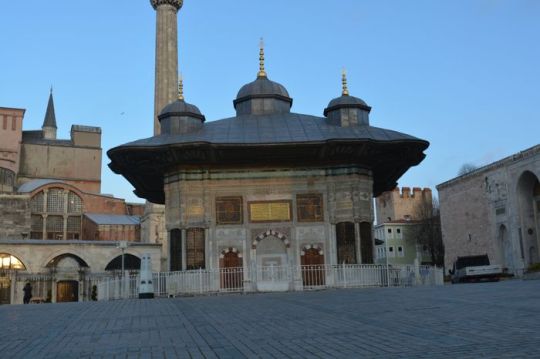
The Greek inscription
The dome is 57 feet in diameter, and rests on eight piers, intersected by a double row of thirty-four green and white columns, sixteen of which are in the lower row, and the remaining eighteen in the galleries. The Greek inscription, running round the frieze, is ornamented with carved vine leaves and grapes, and is a dedicatory poem to the two saints; but all the mosaics and frescoes forming part of the original ornamentation of the church have been covered with whitewash. Ducange states that this was the church in which the papal Nuncio, for the time being, was allowed to hold divine service in Latin ; and it was here that Pope Virgil sought refuge from the wrath of Justinian for having excommunicated Patriarch Menas; this was also the church which the Emperor attended in state every Easter Tuesday.
Mehmed Pasha Mosque, on the south-west side of the Hippodrome, not far from Kutchuk Ayiah Sofia. Admission 5 piastres (10d.). This mosque is regarded (Dr. A. G-. Paspati, ‘ BvavnvaX MeXerat ) as the ancient church of St. Anastasia Pharma- kolytria, variously attributed to Anastasius Dicorus, in the fifth century, and to Gregory Nazianzenus, the latter of whom preached orthodoxy in it during the predominance of Arianism in the city. The church has been rebuilt and restored several times, and notably by Basil of Macedon, who replaced its wooden cupola by a stone one.
Most of the ornaments and relics were carried off by the Latins during the crusade of 1204. The immediate vicinity of this church, extending as far as the Cistern of Philoxenus (Thousand and One Columns), is supposed by Dr. Paspati to have been the site of the city Praetorium and the Portico of Domninus. The church was converted into a mosque in 1571 by Mehmed Pasha Socoll, son-in-law of Selim II. The tiles with which the interior is ornamented guided tours istanbul, and especially those forming the panels over the windows and the canopy over the pulpit, are masterpieces of Persian art. The courtyard is one of the most picturesque, and makes a charming subject for sketches or photographs.
The Church in the Fields
The Church in the Fields (17 Movrj TT)? Xwpa?), now Kahriyeh Jamesi, better known to travellers as the Mosaic Mosque. Admission 5 piastres per head. The Imam (priest) in charge is not always in attendance, but lives close by, and will always come if sent for. This mosque suffered so severely during the earthquakes of 1894 as to be in danger of falling down, and it has been deemed advisable, in consequence, to close it for an indefinite period. It is situated near the land walls and close to Edimth Kaj)u (Adrianople Gate); it is one of the most interesting of all the whilom Byzantine churches, both on account of its plan and of the mosaic pictures covering the walls of its outer and inner nartheces, the greater part illustrating the life of Christ. Its Greek name, showing that it originally stood outside the city, carries the foundation back to the period prior to 413 A.D., when it was enclosed within the walls of Theodosius.
Very probably the church was erected as a private chapel in connection with the Hebdomon Palace. Justinian restored it and added a basilica, and in the early part of the seventh century it was further restored and embellished by Crispus, son-in-law of the Emperor Phocas, who was imprisoned in it for treachery by Heraclius, and subsequently became a monk. In the early part of the twelfth century the church was rebuilt and restored by Maria Ducaina, mother-in-law of Alexius Comnenus; and about the middle of the fourteenth century its chapels and nartheces were again restored throughout and embellished by the patrician Theodoras Metochites.
0 notes